

Refocus: Syllabus Statement. What is current practice?
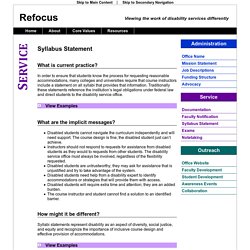
In order to ensure that students know the process for requesting reasonable accommodations, many colleges and universities require that course instructors include a statement on all syllabi that provides that information. Traditionally these statements reference the institution’s legal obligations under federal law and direct students to the disability service office. View Examples Sample 1 Statement on Students with Disabilities: Individuals who have any situation/condition, either permanent or temporary, which might affect their ability to perform in class or access class materials, are encouraged to inform the instructor at the beginning of the term. Sample 2 If you are a student with a disability or believe you might have a disability that requires accommodations, please contact the disability service office to discuss reasonable and appropriate accommodations and eligibility requirements.
Google Docs - create and edit documents online, for free. One account.
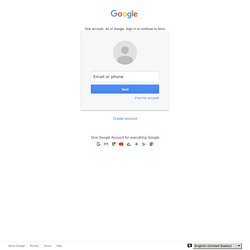
All of Google. Sign in to continue to Docs Find my account. UDL Guidelines 2.0. The goal of education in the 21st century is not simply the mastery of content knowledge or use of new technologies.
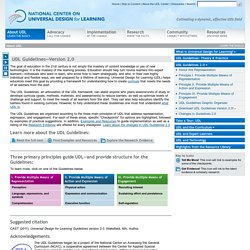
It is the mastery of the learning process. Education should help turn novice learners into expert learners—individuals who want to learn, who know how to learn strategically, and who, in their own highly individual and flexible ways, are well prepared for a lifetime of learning. Universal Design for Learning (UDL) helps educators meet this goal by providing a framework for understanding how to create curricula that meets the needs of all learners from the start. The UDL Guidelines, an articulation of the UDL framework, can assist anyone who plans lessons/units of study or develops curricula (goals, methods, materials, and assessments) to reduce barriers, as well as optimize levels of challenge and support, to meet the needs of all learners from the start.
They can also help educators identify the barriers found in existing curricula. Creating Video and Multimedia Products That Are Accessible to People with Sensory Impairments. And How Universal Design Features Benefit Everyone DVDs, streaming video on the web, and films are engaging instructional tools.
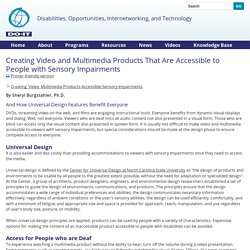
Everyone benefits from dynamic visual displays and dialog. Well, not everyone. Viewers who are deaf miss all audio content not also presented in a visual form. Those who are blind can access only the visual content also presented in spoken form. Organizing your course accessibly. All people learn differently.
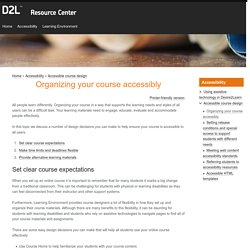
Organizing your course in a way that supports the learning needs and styles of all users can be a difficult task. Your learning materials need to engage, educate, evaluate and accommodate people effectively. In this topic we discuss a number of design decisions you can make to help ensure your course is accessible to all users. Set clear course expectations When you set up an online course it is important to remember that for many students it marks a big change from a traditional classroom. WebA11Y HB2 Print HiRes. Accessibility checkers. A Word of Caution Automated, accessibility testing tools provide a good baseline check for accessibility of HTML web pages, PDFs and Microsoft Office 2010 documents, but the documents still need a human to check the pages and ask these questions: Are headings used to give the document structure?
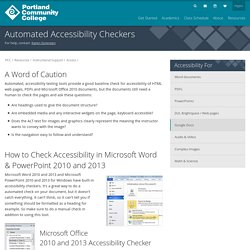
Are embedded media and any interactive widgets on the page, keyboard accessible? Does the ALT text for images and graphics clearly represent the meaning the instructor wants to convey with the image? Insidehighered. The decision last week by the University of California, Berkeley, to take years' worth of video and audio lectures out of the public realm because of federal requirements on accessibility for people with disabilities was decried by many accessibility advocates. And many other universities told Inside Higher Ed this week that they would not be following suit.
IDI Web Accessibility Checker : Web Accessibility Checker. Tips for creating a transcript file - YouTube Help. Transcripts are a simple way of creating captions.
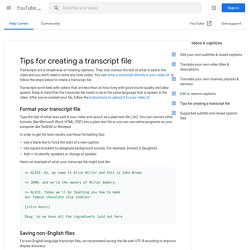
They only contain the text of what is said in the video and you don't need to enter any time codes. Accessibility Tips to accompany our “Make Technology Work for Everyone” video. You are here: Home > Accessibility Tips to accompany our “Make Technology Work for Everyone” video What’s on this page?
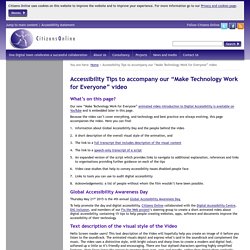
Our new “Make Technology Work for Everyone” animated video introduction to Digital Accessibility is available on YouTube and is embedded later in this page. Because the video can’t cover everything, and technology and best practice are always evolving, this page accompanies the video. Here you can find: Global Accessibility Awareness Day Thursday May 21st 2015 is the 4th annual Global Accessibility Awareness Day.
To help promote the day and digital accessibility, Citizens Online collaborated with the Digital Accessibility Centre, DIG Inclusion, and members of our Fix the Web project‘s steering group to create a short animated video about digital accessibility, containing 15 tips to help people creating websites, apps, software and documents improve the accessibility of their technology. Text description of the visual style of the Video Hello Screen reader users! Podcast: Copyright & UDL, An Interview with Thomas J. Tobin. When it comes to copyrights, do you know the difference between material you create for your class and material you are contracted to create for a class?
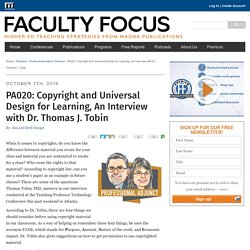
Who owns the rights to that material? According to copyright law, can you use a student’s paper as an example in future classes? These are some of the questions Thomas Tobin, PhD, answers in our interview conducted at the Teaching Professor Technology Conference this past weekend in Atlanta. How to Be Culturally Sensitive with Your eLearning Courses. When I taught English in Japan, I quickly realized that it was easier for my students to learn when the content I used was culturally relevant, or at least not based solely on my cultural perspective.
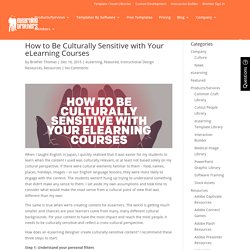
If there were cultural elements familiar to them – food, names, places, holidays, images – in our English language lessons, they were more likely to engage with the content. The students weren’t hung up trying to understand something that didn’t make any sense to them. I set aside my own assumptions and took time to consider what would make the most sense from a cultural point of view that was different than my own. The same is true when we’re creating content for eLearners. The world is getting much smaller and chances are your learners come from many, many different cultural backgrounds. c2f101 f735652b31044b13b8671a389d6514a8. UDL On Campus: Media & Materials.